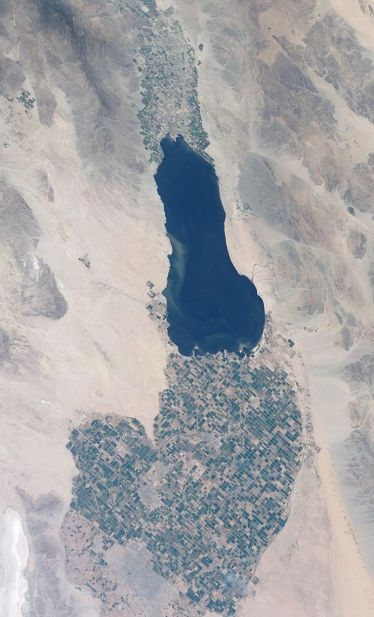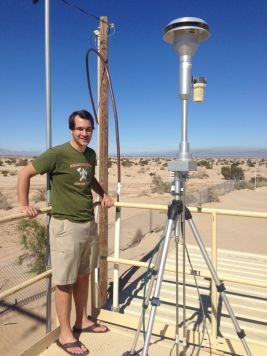Posts Tagged: Salton Sea
New dust sources resulting from a shrinking Salton Sea have negative ecological and health impacts
UC Riverside study shows soils once submerged under the sea and airborne particulate matter are high in sodium and selenium
Scientists at UC Riverside investigating the composition of particulate matter (PM) and its sources at the Salton Sea have found that this shrinking lake in Southern California is exposing large areas of dry lakebed, called playa, that are acting as new dust sources with the potential to impact human health.
“Playas have a high potential to act as dust sources because playa surfaces often lack vegetation,” said Roya Bahreini, an associate professor of environmental sciences, who led the research project. “Dust emissions from playas increase airborne PM mass, which has been linked to cardiovascular disease, respiratory disease, and mortality.”
Study results appeared recently in Environmental Science and Technology.
Bahreini's team set out to test whether emissions from playas change the composition of PM10 (particulate matter with diameters up to 10 microns) near the Salton Sea. The team assessed the composition of playa soils (recently submerged underneath the Salton Sea), desert soils (located farther from the sea), and PM10 collected during August 2015 and February 2016.
They found that dust sources contributed to about 45 percent of PM10 at the Salton Sea during the sampling period while playa emissions contributed to about 10 percent. Further, they found that playa emissions significantly increased the sodium content of PM10.
“Increase in the sodium content of PM10 can affect the ecosystem when the sodium-rich particles deposit downwind and change the natural balance for soils and agricultural lands or when these particles form clouds,” Bahreini said. “Currently, the primary concern for PM emissions from playa is the contribution to total concentration of PM10, which regardless of composition, is an irritant and can have negative respiratory effects.”
Her team also found that playa soils and PM10 are significantly enriched in selenium relative to desert soils.
Bahreini explained that selenium can be a driver of aquatic and avian toxicity. “Additionally, higher selenium enrichments in PM10 during summertime suggest that selenium volatilization from the playa may become an important factor controlling the selenium budget in the area as more playa gets exposed,” she said.
Alexander L. Frie, a graduate student in environmental sciences and the first author of the research paper, urges that the Salton Sea be paid close attention since, although it is widely considered a large ecological disaster, with no serious monitoring and remediation efforts the sea may also create a human health crisis for the surrounding area.
Samantha C. Ying, an assistant professor of environmental sciences and a coauthor on the paper, stresses that monitoring the increase in dust sources over time is necessary to quantify its contribution to local health problems.
“Our study shows that the shrinking Salton Sea is contributing to dust sources in the region,” she said. “Even considering just the small area of playa that is exposed now, the contributions are significant.”
Another concern the researchers point out is that water that is currently diverted from the Colorado River and directed into the Salton Sea is scheduled to end before 2018. The resultant decrease of inflow into the sea will likely cause a decline in water level, exposing more playa, and therefore emitting more dust.
“With more playa being exposed, we expect total PM10 concentrations to increase and human exposure to these particles in downwind areas will also increase,” Bahreini said. “Therefore implementing any project, for example, creating shallow water pools over the playa, that limits formation of salt crusts on the playa will be valuable.”
Bahreini, Frie and Ying were joined in the study by Justin H. Dingle, a graduate student in Bahreini's lab.
The study was funded by UCR Regents' Faculty Development Award, USDA National Institute of Food and Agriculture, a UCR Provost Research Fellowship, the U.S. Geological Survey and ANR's California Institute for Water Resources.
Read more:
KPBS, David Wagner New Study Traces Airborne Dust Back to Shrinking Salton Sea
The Desert Sun, Ian James Studying dust around the Salton Sea, scientists find initial answers
Palm Desert Patch The Hidden, Potentially Deadly, Dangers of The Salton Sea
Scientists seek solutions to Salton Sea woes
The rotten-egg stink that invaded Southern California in September was blamed by scientists on an unfortunate combination of a large fish die-off in the Salton Sea, a storm churning the fetid lower levels of the sea and unusual gusts from the southeast blowing the odors toward Los Angeles, according to the Los Angeles Times.
That was just latest episode in a series of environmental woes for the lake that formed 150 miles southeast of Los Angeles in 1905 when the Colorado River flooded the Sonoran Desert. Now the Salton Sea is mainly fed by fresh water drainage from nearby farms and waste water from Mexicali, but becoming more salty as evaporation outpaces its replenishment. UC scientists are working on ways to improve the quality of the inland sea to make it more hospitable to wildlife.
Nitrogen and phosphorus are two main nutrients that spur algae growth and lower dissolved oxygen concentrations that cause massive fish kills in the Salton Sea.
Imperial Valley growers often fertilize their crops with nitrogen and phosphorus in irrigation water. Khaled Bali, UC Cooperative Extension advisor in Imperial County, gives growers “best management techniques” to ensure fertilizers are applied correctly so the nutrients end up the plants, not flowing into the Salton Sea.
“One of the irrigation management practices that we developed at the UC Desert Research and Extension Center is used in the valley to conserve water and improve water quality,” Bali said. “Implementation of this practice on commercial farms increases water use efficiency by more than 12 percent and reduces the load of sediment and soluble phosphorus in drainage water by more than 50 percent.”
A recent UC Berkeley study has demonstrated a cost-effective method for using manmade wetlands to clean contaminants out of the waters that flow into the sea, which is overly salty from evaporation and polluted with selenium, fertilizer nutrients and other chemicals from agricultural run-off.
The study was aimed at providing a wildlife habitat at the south end of the sea with low-salt, clean water, but the new wetland design also has the potential for broader environmental and agricultural applications, researchers say.
“No other published studies have shown any cost-effective system that approaches this level of efficient selenium removal,” said Norman Terry, professor in the Department of Plant and Microbial Biology at UC Berkeley, and principal investigator of the study. “The only other way to get water this clean is to use microbial bioreactors, which are prohibitively expensive and not feasible on the vast scale of the Salton Sea.”
In the proposed multi-step process, water from the Alamo or New River would be pumped into a sedimentation pond, and then allowed to flow through an algae pond and into a constructed wetland growing cattail plants before it finally enters into the species conservation habitat.
Terry’s next step is to obtain funding to build a pilot wetland to test the design in the field.
The study, published in the November 6 issue of Environmental Science and Technology, was funded as part of the California Department of Fish and Game's and Department of Water Resources’ efforts to develop pilot restoration projects that provide feeding habitat for migratory, fish-eating birds.




